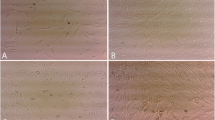Abstract
Tissue regeneration following radiotherapy occurs due to the survival and regenerative abilities of tissue stem cells and resident or invading mesenchymal stem cells (MSCs), and their functional characteristics depend significantly on their sensitivity to ionizing radiation. The aim of this work was to study the effect of long-term cultivation of adipose tissue–derived MSCs on their radiosensitivity and the ability to repair DNA double-strand breaks (DSBs). To determine whether in vitro expansion influences the sensitivity of MSCs to low and sublethal doses of γ-radiation, we maintained short- and long-term MSC cultures and analyzed their radiosensitivity at early and late passages. MSCs possessed a high telomerase activity at passage 6 (P6) and an extremely low one at passage 30 (P30). The doubling time of cells by passage 30 decreased by 7 h. MSCs irradiated at P30 demonstrated significantly decreased survival seven days after irradiation at 0.1 and 1 Gy compared with the control and P6 cultures. The clonogenic activity of MSCs irradiated at P30 and P6 was the same. MSC cell cycle analysis at P30 and P6 indicated G0/G1 arrest after 24 h, but G2/M arrest at 6 Gy after seven days. The P30 MSCs were able to repair DNA DSB efficiently after γ-irradiation. Even after irradiation at a dose of 6 Gy, P30 MSCs maintained their ability for adipocyte differentiation and cytokine secretion. These results demonstrate that, after long-term cultivation, adipose tissue-derived MSCs maintain the ability to repair DNA DSB and possess stable functional characteristics and differentiation potential after irradiation, suggesting their resistance to sublethal doses of γ-radiation. They can also retain their functions in the tissue surrounding the irradiated organ.







Similar content being viewed by others
REFERENCES
Akita, S., Akino, K., Hirano, A., et al., Mesenchymal stem cell therapy for cutaneous radiation syndrome, Health Phys., 2010, vol. 98, no. 6, pp. 858–862.
Tolar, J., Le Blanc, K., Keating, A., and Blazar, B.R., Concise review: hitting the right spot with mesenchymal stromal cells, Stem Cells, 2010, vol. 28, pp. 1446–1455.
Niwa, O., Barcellos-Hoff, M.H., Globus, R.K., Harrison, J.D., Hendry, J.H., Jacob, P., Martin, M.T., Seed, T.M., Shay, J.W., Story, M.D., Suzuki, K., and Yamashita, S., ICRP publication 131: Stem cell biology with respect to carcinogenesis aspects of radiological protection, Ann. ICRP, 2015, vol. 44, nos. 3–4, pp. 7–357.
Lynam-Lennon, N., Reynolds, J.V., Pidgeon, G.P., et al., Alterations in DNA repair efficiency are involved in the radioresistance of esophageal adenocarcinoma, Radiat. Res., 2010, vol. 174, pp. 703–711.
Wang, Y., Zhang, Z., Chi, Y., et al., Long-term cultured mesenchymal stem cells frequently develop genomic mutations but do not undergo malignant transformation, Cell Death Dis., 2013, vol. 5, no. 4, p. e950.
Baxter, M.A., Wynn, R.F., Jowitt, S.N., et al., Study of telomere length reveals rapid aging of human marrow stromal cells following in vitro expansion, Stem Cells, 2004, vol. 22, no. 5, pp. 675–682.
Zuk, P.A., Zhu, M., Mizuno, H., et al., Multilineage cells from human adipose tissue: implications for cell-based therapies, Tissue Eng., 2001, vol. 7, no. 2, pp. 211–228.
Glukhov, A.I., Zimnik, O.V., Gordeev, S.A., and Severin, S.E., Inhibition of telomerase activity of melanoma cells in vitro by antisense oligonucleotides, Biochem. Biophys. Res. Commun., 1998, vol. 248, pp. 368–371.
Macphail, S.H., Banath, J.P., Yu, T.Y., et al., Expression of phosphorylated histone H2AX in cultured cell lines following exposure to X-rays, Int. J. Radiat. Biol., 2003, vol. 79, no. 5, pp. 351–358.
Krutzik, P. and Nolan, G., Intracellular phospho-protein staining techniques for flow cytometry: monitoring single cell signaling events, Cytometry, Part A, 2003, vol. 55, pp. 61–70.
Moskaleva, E.Yu., Semochkina, Y.P., Rodina, A.V., et al., Effect of radiation on mesenchymal stem cells of mouse bone and brain marrow and their ability to induce tumors, Radiats. Biol., Radioekol., 2017, vol. 57, no. 3, pp. 245–256.
Wong, K.K., Chang, S., Weiler, S.R., et al., Telomere dysfunction impairs DNA repair and enhances sensitivity to ionizing radiation, Nat. Genet., 2000, vol. 26, pp. 85–88.
Sishc, B.J., Nelson, C.B., McKenna, M.J., et al., Telomeres and telomerase in the radiation response: implications for instability, re-programming, and carcinogenesis, Front Oncol., 2015, vol. 24, no. 5, p. 257.
Kakarougkas, A. and Jeggo, P.A., DNA DSB repair pathway choice: an orchestrated handover mechanism, Br. J. Radiol., 2014, vol. 87, no. 1035, art. ID 20130685
Shrivastav, M., De Haro, L.P., and Nickoloff, J.A., Regulation of DNA double-strand break repair pathway choice, Cell Res., 2008, vol. 18, no. 1, pp. 134–147.
Maria, O.M., Kumala, S., Heravi, M., et al., Adipose mesenchymal stromal cells response to ionizing radiation, Cytotherapy, 2016, vol. 18, no. 3, pp. 384–401.
Funding
This work was supported by the Russian Foundation for Basic Research, project no. 15-29-01234.
Author information
Authors and Affiliations
Corresponding author
Ethics declarations
Conflict of interest. The authors declare that they have no conflict of interest.
Statement on the welfare of animals. All applicable international, national, and/or institutional guidelines for the care and use of animals were followed.
Additional information
Translated by M. Batrukova
Rights and permissions
About this article
Cite this article
Rodina, A.V., Semochkina, Y.P., Vysotskaya, O.V. et al. Features of the Response of Long-Term Cultured Adipose Tissue–Derived Mesenchymal Stem Cells to γ-Irradiation. Biol Bull Russ Acad Sci 48, 2060–2070 (2021). https://doi.org/10.1134/S1062359021110078
Received:
Published:
Issue Date:
DOI: https://doi.org/10.1134/S1062359021110078




